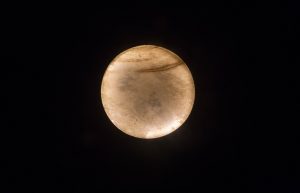Concordia grad and fellow artist combine forces to empower each other and viewers
Artist Émilie Monnet and recent Concordia MFA graduate Dayna Danger were asked to exhibit their work as part of the OBORO art centre’s year-long dedication to Indigenous artists and thinkers in response to the Canada 150 celebrations.
In collaboration with five women from the Native Women’s Shelter of Montreal, the artists took the opportunity to put together a month-long exhibition centred around the empowerment of Indigenous women.
OBORO’s website states Monnet and Danger’s project, Sanctuary, “explores how one can create a feeling of sanctuary in one’s self.” It encourages Indigenous women to understand that their own bodies and ancestry can provide the refuge that their colonized land cannot. The small exhibition at OBORO is just one element of the centre’s ongoing project. This single-room exhibition consists of both photographic and audio pieces, and explores stars and their significance in all Indigenous cultures.
The photography aspect of the exhibition features portraits of the five Indigenous women from the shelter—Brenda Lee Marcoux, Gail Golder, Jenna Guanish, Violet Rose Quinney and Crystal Star Einish—embodying empowered alter-egos, or “star selves.” Their star selves were discovered through workshops with the artists and other collaborators, and included links to their ancestors. For example, in her portrait, Quinney chose to dress as her grandfather.
However, Monnet and Danger noted that the empowered personas the women chose were not far off from who they really are. “It was something that we didn’t really expect,” Danger said. “It was really beautiful.”
The portraits are laminated onto copper “shields,” because some Indigenous cultures believe the metal has healing properties. These shields hang from the ceiling in an inwards-facing circle, creating a powerful space that one has to physically enter in order to view the work.

On the wall to the right of the entrance hangs a hand drum, which is lit from behind. It casts a beam of light across the room onto the portraits, specifically onto the one of a woman holding a similar drum. “The drum lit up could be a reference to the moon,” Danger said.
The exhibition’s audio component consists of two parts: an ambient noise which fills the intimate, dark gallery space, and a voice recording played on headphones made available next to the hanging shields.
The ambient noise is made up of an Indigenous song sung by the artists as well as bits of conversation with the collaborators. The recording played through the headphones, is a dialogue from the workshops leading up to the exhibition, as well as intimate monologues that each woman wrote for their created alter-ego.
The atmosphere of the gallery space used for the exhibition aids in conveying the ideas of stars and restfulness. Upon entering the room, viewers feel a sense of sanctuary, as they are easily immersed in the exhibition through the blanket of darkness and placement of the pieces. The sound aspect of the installation helps contribute to the feeling of calm and comfort viewers experience. Additionally, the darkness of the room gives the few lit objects more visibility and significance, just as stars light up a pitch-black night sky.
According to Danger, the aim of this project was to guide Indigenous women in “seeing themselves in a positive and empowering way.” She added that she also hopes the public, in seeing the exhibition, would echo that vision.
“Even somebody who isn’t Indigenous is going to come in there and find some resonance with what is being said,” she said.
Wishes / Souhaits is on display until Oct. 21 at the OBORO gallery space at 4001 Berri St. The gallery is open Tuesday to Saturday from 12 p.m. to 5 p.m. For more information on OBORO’s year of Indigenous programming and upcoming exhibitions, check out their website.
A previous version of this article misquoted Dayna Danger with regards to the focus and aim of most Indigenous art. The Concordian apologizes for the error.





It’s really disheartening to see a catalogue text written by an Indigenous, Two-Spirit person taken so out of context, and then used to misquote Dayna and to make grandiose statements that could be detrimental to Dayna’s career, and the Indigenous art community as a whole. This feels very non-consensual and colonial.
Artist is extremely misquoted and the writer does not understand the project.